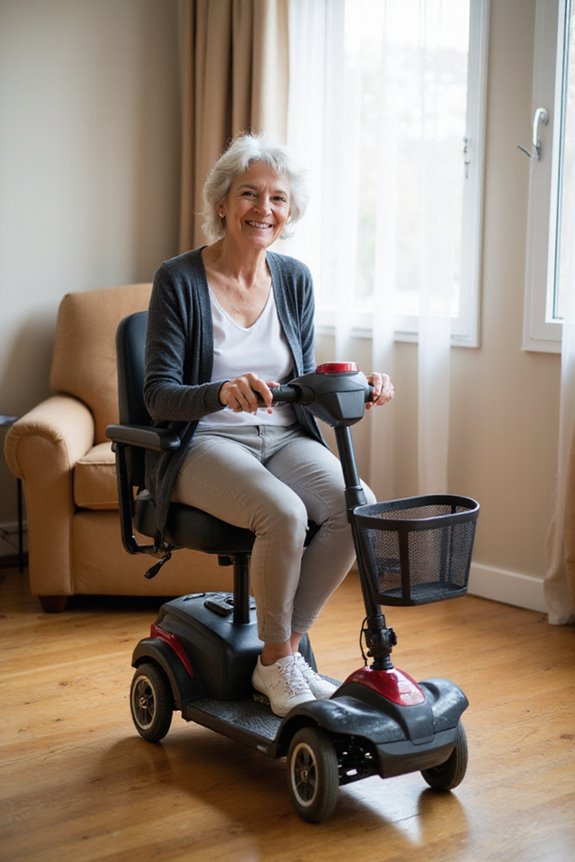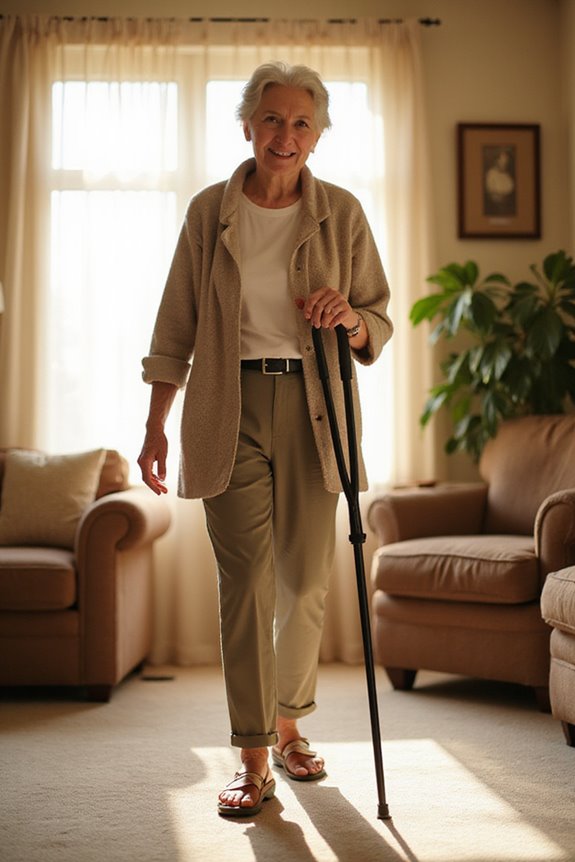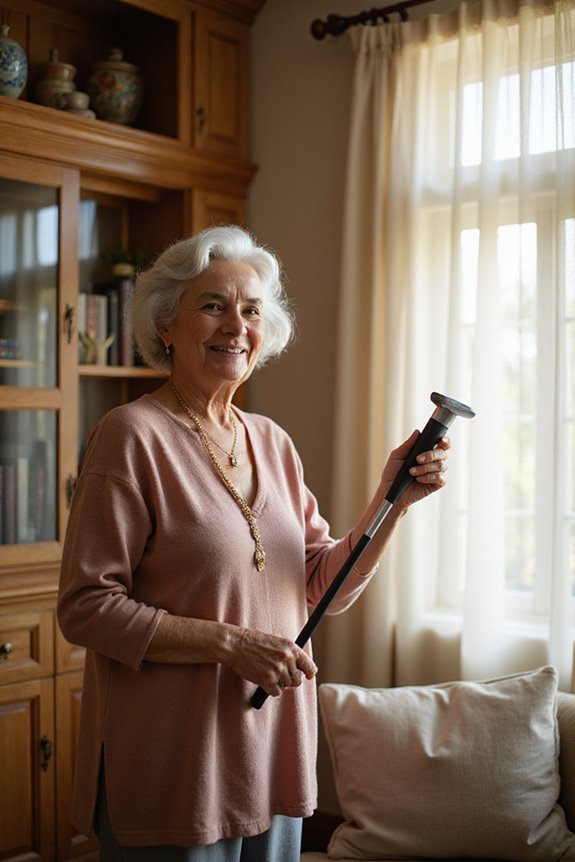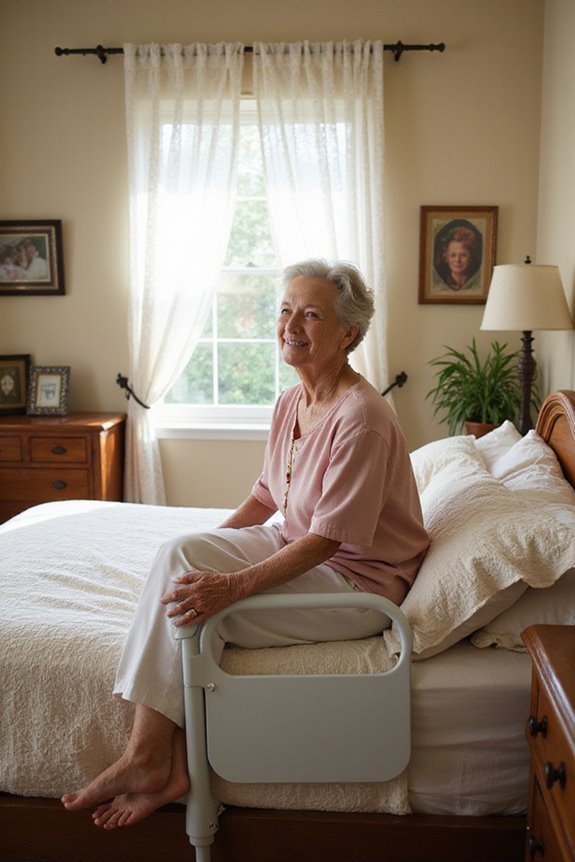Knee scooters serve as a viable alternative to crutches, offering several advantages. They provide enhanced stability, with a lower fall rate of 14 incidents compared to 22 for crutches. The rolling motion reduces upper body strain, making them more comfortable and allowing for longer usage periods. Although they initially cost more than crutches, long-term use may represent better value. Users experience improved rehabilitation adherence due to the ergonomic design that promotes even weight distribution. Further insights await.
Key Takeaways
- Knee scooters provide better comfort and stability, reducing strain on the upper body compared to crutches.
- They feature a four-wheel design, enhancing maneuverability and outdoor performance.
- Knee scooters may have higher initial costs but offer better long-term value for extended use.
- Users report fewer falls and improved safety with knee scooters than with crutches.
- The rolling motion of knee scooters requires less energy, allowing for longer periods of mobility.
Cost Comparison: Crutches vs. Knee Scooters
When evaluating the cost comparison between crutches and knee scooters, several factors must be considered.
Cost of Acquisition
- Crutches typically cost less upfront and are often covered by insurance, enhancing their cost effectiveness.
- Knee scooters start at over $100, with high-end models reaching up to $200.
Rental Options
- Crutches can be rented at low rates, while knee scooters may cost $20-$40 per week.
- Renting knee scooters can be economical for short-term use.
Long-Term Value
- For long-term use, purchasing a knee scooter may offer better value despite higher initial costs.
- Budget considerations are essential, particularly for those with limited financial resources, influencing the choice between these mobility aids. Additionally, many users report enhanced mobility and stability with knee walkers compared to crutches, making them a worthwhile investment for recovery.
Mobility and Maneuverability: Finding Your Fit
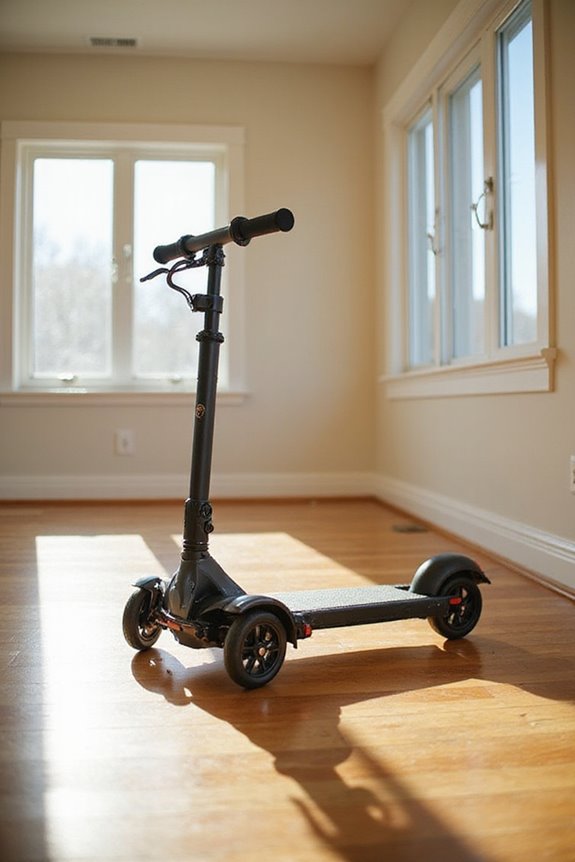
Mobility and maneuverability are critical factors to evaluate when choosing between knee scooters and crutches.
Knee Scooter Advantages
- Four-wheel design offers superior stability on various surfaces.
- Smooth-rolling wheels enhance outdoor performance.
- Lower center of gravity reduces fall risk, particularly on uneven terrain.
Crutch Disadvantages
- Lightweight and compact, crutches excel in tight spaces and are easier to transport.
- Require significant upper body strength, leading to fatigue over time.
- More suitable for traversing stairs, unlike knee scooters which are generally unsuitable for stair navigation.
Accessibility can be a concern, as some facilities may not accommodate the width of knee scooters. It is essential to take these factors into account when determining the best option for individual mobility needs. Additionally, the weight capacity of mobility aids should be considered to ensure safety and stability for all users.
Comfort Level: Strain on the Body
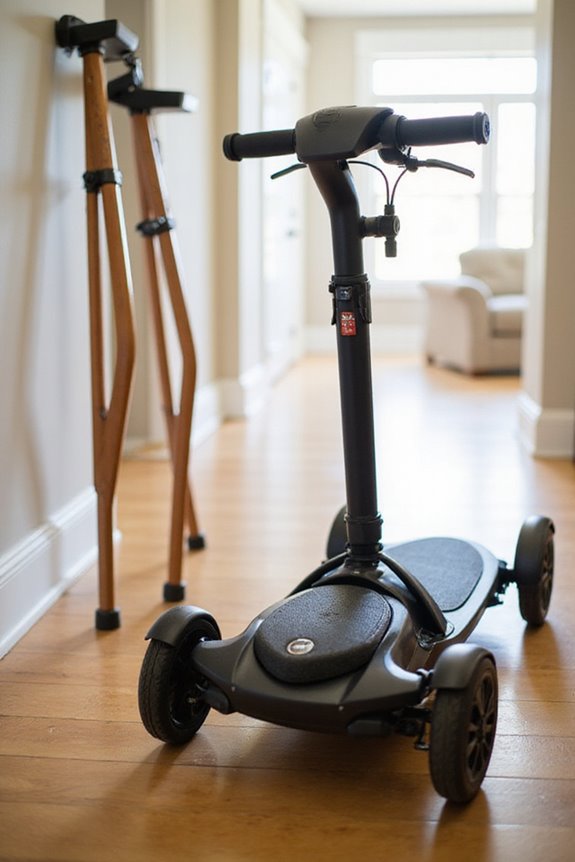
Although both knee scooters and crutches serve to facilitate mobility during recovery, their impact on user comfort and strain on the body differs greatly.
Weight Distribution
- Knee scooters offer more even weight distribution, considerably reducing upper body strain.
- Crutches exert pressure on the underarms and hands, often leading to discomfort and potential nerve issues.
Energy Efficiency
- Users expend less energy on knee scooters due to a rolling motion, which lowers fatigue.
- Crutches require considerable upper body strength, increasing exhaustion during prolonged use.
Posture and Alignment
- Knee scooters promote symmetrical posture, minimizing compensatory strain on the body.
- Crutches can lead to imbalanced weight distribution, causing discomfort in non-affected limbs. Furthermore, many walkers with brakes feature ergonomic designs that enhance user comfort and stability during movement.
Safety and Stability: Risk Assessment
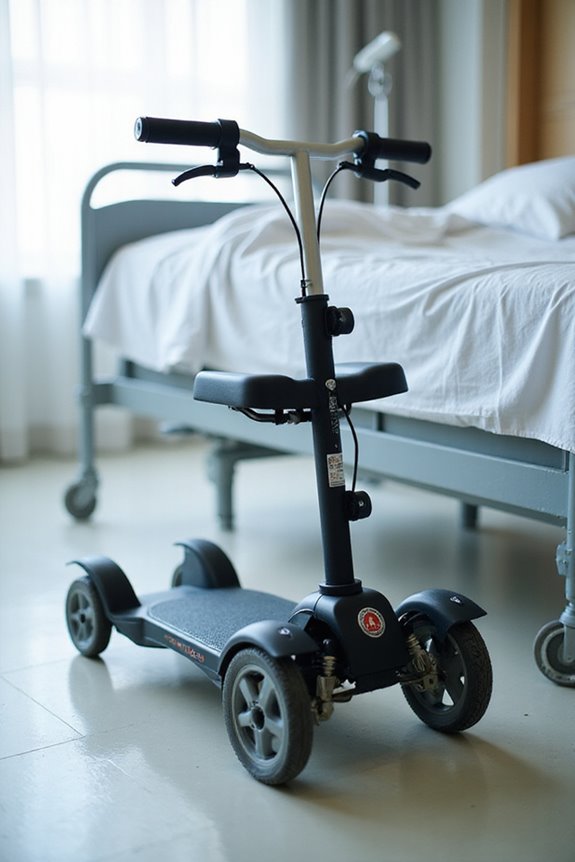
Safety and stability are critical considerations when evaluating mobility aids such as knee scooters and crutches.
- Falls and Accidents: Knee scooters demonstrate lower fall rates, with 14 falls reported compared to 22 with crutches.
- Weight Distribution: The design of knee scooters provides better weight distribution, reducing tipping risks.
- User Demographics: Older adults may face increased fall risks; however, both aids show similar statistics across age and gender.
- Stability Features: Knee scooters feature a wider wheelbase and adjustable components, enhancing user control and stability.
- Upper Body Strength: With less reliance on upper body strength, knee scooters accommodate a broader range of users, improving safety for individuals with varying body weights.
Adhering to safety guidelines is essential for ideal use of both devices.
Practical Limitations: Where Each Aid Excels
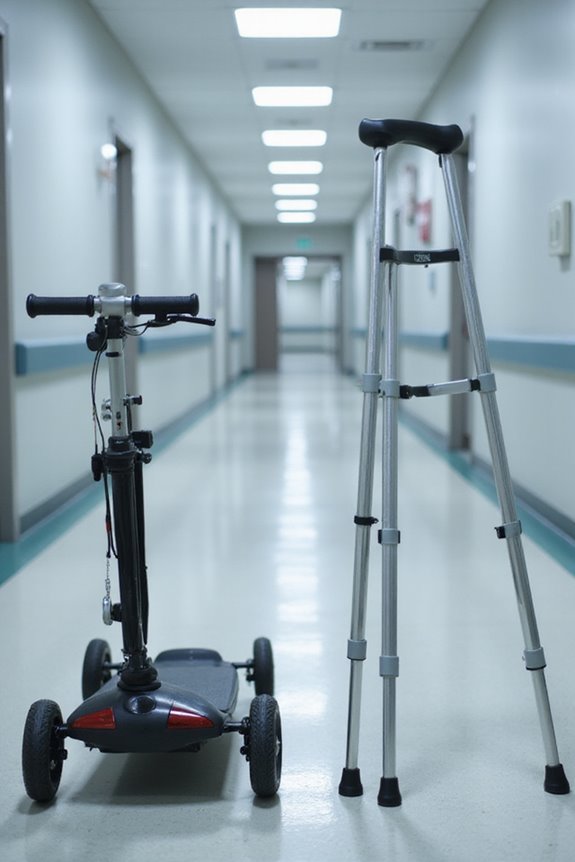
Practical limitations of knee scooters and crutches become apparent when evaluating their performance in various environments and user scenarios.
Maneuverability and Space Navigation
- Crutches excel in narrow hallways and stairs, while knee scooters perform better in wide, flat areas.
- Crutches are portable, ideal for users with limited vehicle space, whereas knee scooters are bulkier.
Comfort and Physical Demand****
- Knee scooters offer a padded platform, reducing strain for extended use.
- Crutches require significant upper body strength, which may be challenging for some users.
Weight Capacity and User Suitability****
- Crutches have weight restrictions, making them less suitable for heavier users.
- Knee scooters accommodate a broader weight range and are gentler for those with multiple injuries. Additionally, certain walkers like the Medical King can support up to 350 lbs, enhancing stability for heavier users.
Weather and Environmental Adaptability
– Crutches provide better control in adverse weather, while knee scooters are better suited for dry, flat surfaces.
Patient Satisfaction: Experiences and Preferences
Patient satisfaction regarding mobility aids, specifically knee scooters and crutches, reveals notable preferences and experiences among users. Satisfaction surveys indicate that knee scooters generally receive higher satisfaction rates due to their comfort and ease of use.
- Patient Testimonials: Many users report reduced upper body strain and improved mobility experiences with knee scooters, contributing to a more positive recovery.
- Preference for Future Use: Patients frequently express a desire to use knee scooters for future surgeries, highlighting their increased independence and energy efficiency.
- Stability and Balance: Knee scooters provide better stability, which further enhances user satisfaction.
In contrast, crutches are noted for specific situations, such as stair navigation, but often lead to discomfort and lower overall satisfaction among users.
Rehabilitation Impact: Enhancing Recovery
Rehabilitation outcomes can be considerably influenced by the choice of mobility aid, with knee scooters emerging as a highly effective option for enhancing recovery.
Stability and Safety
- Knee scooters offer a stable, four-wheel base, reducing fall risks compared to crutches.
- Users report no falls, indicating improved safety during rehabilitation.
Comfort and Physical Impact
- The cushioned knee platform enhances comfort, allowing for proper limb elevation.
- Reduced upper body strain minimizes secondary injuries, promoting longer mobility periods.
Mobility and Independence****
- Knee scooters facilitate faster movement and support self-sufficiency through storage options.
- They promote engagement in routine activities, positively impacting the recovery timeline.
Rehabilitation Efficiency
- Studies indicate prolonged ambulation periods with knee scooters, correlating to improved adherence to rehabilitation strategies.
- Their design decreases complications, thereby enhancing recovery outcomes.
Frequently Asked Questions
How Long Can I Use a Knee Scooter Before Needing Adjustments?
The duration for using a knee scooter before adjustments varies, typically requiring maintenance and adjustments weekly during early recovery. Regular checks for comfort and stability guarantee safety and peak performance throughout the healing process.
Can Knee Scooters Be Used Outdoors in Rainy Conditions?
Knee scooters can be used outdoors in rainy conditions, but outdoor stability is compromised. Users must prioritize rainy safety by choosing appropriate paths and slowing down, ensuring a secure experience despite challenging weather.
Are There Any Age Restrictions for Using Knee Scooters?
Age suitability for knee scooters embraces various users, from children to seniors. User guidelines emphasize safety and comfort, ensuring individuals of all ages can confidently navigate recovery while fostering a sense of community during their healing journey.
How Do I Transport a Knee Scooter in a Vehicle?
Transporting a knee scooter involves utilizing its foldable features for improved vehicle compatibility. Properly preparing the vehicle space guarantees safe storage, while techniques for loading and unloading enhance the experience, fostering a sense of belonging and independence.
What Accessories Are Available for Knee Scooters?
Knee scooters come equipped with various accessories, including soft knee pads for comfort and convenient storage bags for personal items. These enhancements foster a sense of belonging, making mobility enjoyable and practical for users in diverse environments.

